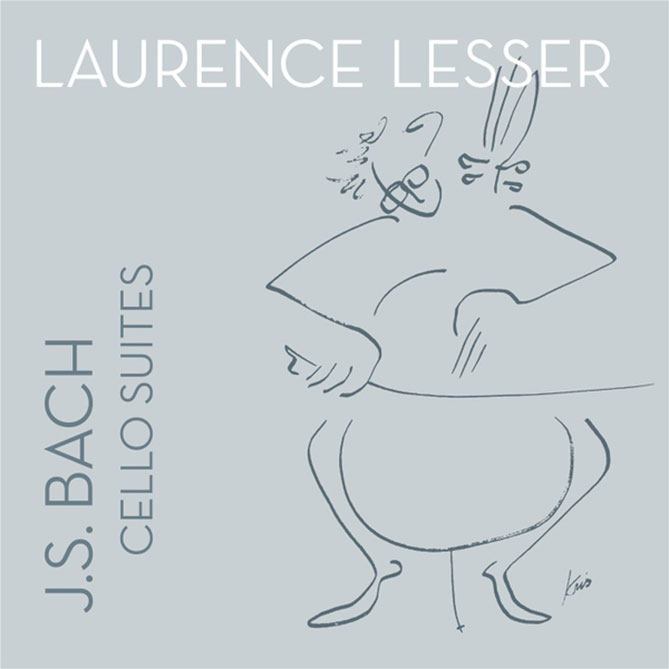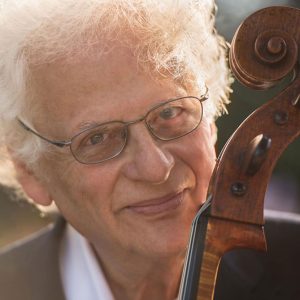
Some Thoughts About My Bach Recordings
Laurence Lesser
When anyone approaches the Bach Cello Suites, it’s natural to begin thinking about a “correct” way to play them. My teacher, Gregor Piatigorsky, used to say: “Never play for the cellists in the audience—they always have a different idea.” Start that instead with “Never play Bach for . . .” and life gets even harder!
Like every young cellist of my generation, I was very influenced by the recordings of Pablo Casals. How could I not be? He was considered the “greatest” cellist of his day and my then teacher, Gabor Rejto, had studied with him. And how could one deny the performances of an artist who always convinced you, at least as long as his sounds were in your ears. I was lucky enough to play the D minor suite for him in 1961 and his ideas made a big impression on me.
But as I became a professional musician, there was a wonderful new and fresh voice speaking through his playing about the Suites—Anner Bylsma. I am very lucky to have become his friend—and his ideas continue to stimulate me immeasurably. By now he has written 3 volumes about the Suites (the 3rd has just been published) and sandwiched between them is a volume about Bach’s works for solo violin.
But, when you get right down to it, there is only one Pablo Casals and only one Anner Bylsma.
And, of course, I am neither. And all that is just for starters.
Here are the dilemmas:
I play a 1622 Amati cello. When Bach wrote the Suites, my cello was approaching age 100. Certainly Bach’s thinking wasn’t limited by what one could expect from a cello in 1622—at that time maybe just bass lines, sometimes for a church procession. In fact, my own cello is considered originally a “bassetto” and has a plugged hole in the back where one could have attached a strap so it could be played while walking (too bad that Woody Allen didn’t know about that in his movie, Take the Money and Run). Its size has been somewhat diminished to conform to what soon become the norm for a cello.
I recorded the Suites using a Nicolas Maire bow, made around 1860. That kind of bow didn’t become known and fashionable until those made by François Tourte appeared around 1785. And, yes, I could have gotten a Baroque bow, played without an endpin, used all gut strings (as I did when I began playing in 1944 and for maybe 12 more years) and tuned to A=415. But I didn’t. I am lucky to have beautiful “old” equipment, but how can I ignore that I live today?
I don’t know by now how many times the Suites have been recorded. And sound recording is a gift of Edison and developed primarily in the early 20th century. But if we could hear a recording of Bach or his contemporaries, would we feel bound to obey how it sounds? I suspect there anyway would by now be countless recordings of this music, different in many ways from those recordings. Interestingly, Rachmaninoff is said to have played his piano works differently every time—probably because he changed how he felt, but also because he hoped his playing wouldn’t be imitated.
And so, WHAT DO I DO?
I start with striving to be informed.
There is by now plenty of musicological material available that gives us information from Bach’s era about “how to play.” Serious musicians today continue to share their ideas about all of that. I try to pay attention to them.
When Bylsma says “Anna Magdalena” is the true source (since we don’t have the composer’s manuscript), I take it seriously. I study her copy with great interest and care and I have learned a lot from it. To be sure, when I started Bach as a young player, most cellists said that its bowings were so irregular that one shouldn’t even bother to look at her copy. That’s a severely limited viewpoint. But bowings (slurs) in the Baroque, just as later, are not just mechanical instructions, but are put there to show something about the phrase, and while they should not be ignored, they can also be dealt with as ideas and suggestions, not “categorical imperatives.” Anyway, that is how I think about it. At the very least, if I can respect the phrase, how I achieve it is my problem, not the listener’s.
I also lean heavily on the 1720 fair copy Bach made of the works for solo violin. He is known to have been an excellent string player and one can play those pieces with the bowings just as he wrote them. But maybe Bach would have chosen different ones if he used different equipment, like the French bow? Certainly he was always curious about and eager to play the newest style of keyboard instruments. We must be ever grateful to Anna Magdalena for her copy, but I still put my greatest faith in J.S.’s manuscripts where they are available. That is also why I use the lute version, which exists in his manuscript.
Finally, in the early 1990’s Witold Lutosławski visited New England Conservatory. At a lunch in his honor he was asked which composer had influenced him the most. His answer was surprising. “John Cage,” he said, “because he liberated my thinking—he helped me understand finally that I could write whatever and however I wanted.”
And, in a recent reissue of Bylsma’s recorded output there is a preface by the American cellist, Kenneth Slowik, quoting Bylsma thus: “Authentic doesn’t mean historically correct, but rather, ‘just as alive as it ever was.’”
Each of them in a different way has liberated me!
But what does that mean?
Anyone who performs does so because he needs to communicate—that’s my duty.
It doesn’t matter the medium. Cello is my tool. I play music because I want to say something through it to the listener. If I play in a “correct” way but don’t project my thoughts and feelings about the music, that’s just as worthless as if I paid no heed to what I can learn about what has come before. The Suites haunt me and are astonishingly deep and wonderful messages from a great master. So, simply know that what you will hear in my playing has been kicking around inside of me for a long time; that how I play is my own personal recipe using the finest ingredients I can assemble. The music has to speak to me first before it can be given to the listener. But, finally, these recordings are how I felt at the moment I played for the microphone and that is always subject to change.
I certainly hope my playing of them now is “alive as it ever was.”
Subjects: Artistic Vision
Tags: Bach Suites, cellobello, CelloBlog, laurence lesser
